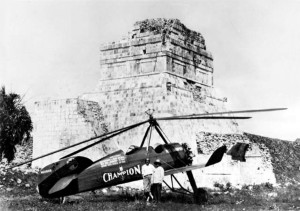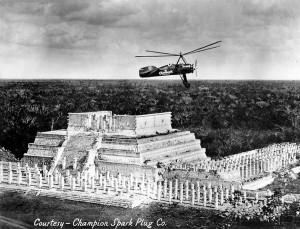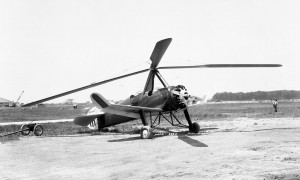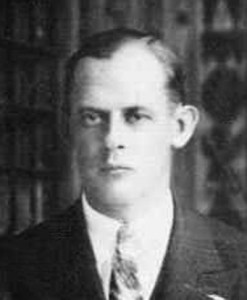Published on September 25, 2012
The Pitcairn PCA-2 autogyro was developed in 1931 and proved to be a reliable, unique aircraft. The rotor at its top was unpowered and it flew more like a fixed wing aircraft than a helicopter, based on the power from its radial engine on the nose. Once at speed, the rotor spun based on aerodynamic forces alone thus generating lift. It was an amazing sight and attracted crowds wherever it flew. By April of 1931, the autogyro had flown across the United States at the hands of John M. Miller, had landed on the White House lawn (by test pilot Jim Ray), and had soared to a new altitude record of 18,415 feet (this being Amelia Earhart’s record).
Seizing upon the press interest in the design, the Champion Spark Plug company purchased one and painted the sides with their logo and named it “Miss Champion”. It was the perfect flying billboard. After hiring Captain Lewis “Lew” Yancey, a former Naval Lieutenant and USCG officer who was a maritime captain, they directed that he fly the nation on an advertising tour. By the end of 1931, Captain Yancey had flown the autogyro 6,500 miles, transiting 21 states and touching down in 38 cities around the nation. Yet the Champion Spark Plugs company still wanted more attention — and thus they asked him to beat Amelia Earhart’s altitude record as well.

During January 1932, having flown south to avoid the northern winters, Captain Yancey took “Miss Champion” from Miami to Havana, Cuba, where it arrived amidst fanfare and the usual press interest. From there, he flew onward to Mexico’s Yucatan Peninsula where he used the unique slow flight characteristics of the autogyro to partcipate in an archaeological exploration of the Mayan pyramids and ruins. It proved very effective in this role, spanning many miles of jungle and finding sites that would have been missed by ground search teams. It was a dream opportunity for the Champion Spark Plug Company, which garnered wide attention from its sponsorship of the archaeological research and came away with some absolutely stunning publicity photos.

Returning to the USA over the summer, Captain Yancey then set about lightening the aircraft and preparing for his altitude attempt. At altitudes above 12,500 feet, the air begins to grow thin and pilots can experience hypoxia. The higher one flies, the colder it becomes and the less oxygen is available. Thus, a flight above 18,000 feet was not without dangers, though Yancey was experienced and quite well prepared. Still, an autogyro is a different aircraft than a fixed wing airplane — while it should perform well, one could never quite tell.

The weather and circumstances to make the record attempt all lined up on September 25, 1932 — 80 years ago today in aviation history. Captain Yancey climbed aboard and took off in the autogyro. Orbiting upward, he soon reached 10,000 feet. As expected, as the autogyro climbed, the engine produced less and less power while simultaneously the thinning air meant that the aircraft had to fly faster through the air to stay aloft. Reaching 15,000 feet, the climb rate had tapered off. Each additional thousand feet took more time. Passing Earhart’s record of 18,415 feet, he was clawing for every 100 feet of altitude.
Passing 21,000 feet, the autogyro was nearing its top altitude. As fuel burned off, the PCA-2 could inch its way higher. Soon the climb rates were less than 50 feet per minute. Then they were just 10 feet per minute. Finally, it seemed that the aircraft could go no higher. Just shy of 21,500 feet, he continued to burn off fuel until the aircraft finally pegged the nice, round number o 21,500 feet. After that, he throttled back and began the long descent into breathable, warmer air. Captain Yancey landed safely and Miss Champion had logged yet another record for the newspapers.

Perhaps only the Vin Fiz and Cal Rodgers had garnered as much media attention for a company — and the autogyro had set a new standard in advertising. It was an inspiring lesson — and one that was not lost on the executivces of other companies, like Goodyear. But that is another story.
One More Bit of Aviation Trivia
Amelia Earhart crashed in her PCA-2 autogyro while in Michigan in front of her new husband, George Putnam. He described it thus: “As I swung around I saw the giro, its rotors splintered, disappear in a cloud of smoke. I vaulted the rail and raced for the wreck. Never have I run so fast, until one of those guy wires caught my pumping legs exactly at the ankles. I did a complete outside loop, up into the air and over, landing full on my back… Coming to my senses, some of them at least, I saw AE emerge from the welter of dust and wave her hands in the air to show she was unhurt.” Putnam suffered three cracked ribs and was the only “casualty” of the plane accident that day.
Today’s Aviation Trivia Question:
Can you loop an autogyro?

Yes, a loop is all positive G.
Very good answer — has it ever been done and, if so, whom and where?
Whatever happened to the autogyros? Sounds like a reasonably successful design. Why are they no longer in use?